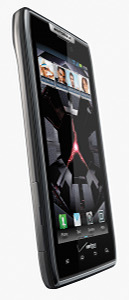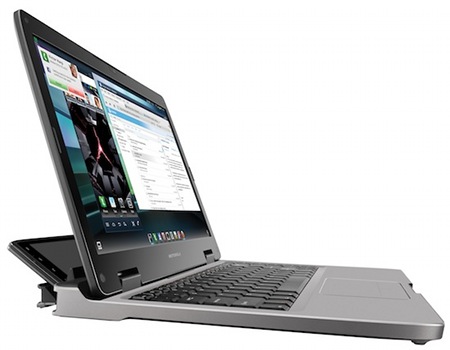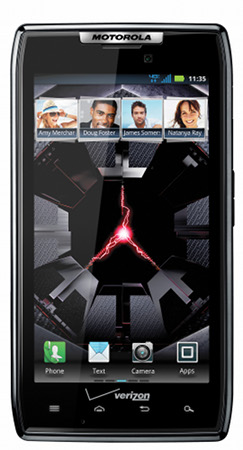Motorola’s latter-day Razr is ‘thinnest 4G LTE smartphone’
Oct 18, 2011 — by LinuxDevices Staff — from the LinuxDevices Archive — viewsMotorola Mobility announced the Droid Razr, a high-end Android phone whose Kevlar-reinforced case is just 0.28 inches thick. Aimed at Verizon's 4G LTE network, it features a dual-core, 1.2GHz processor, 1GB of RAM and 16GB of flash storage, a 4.3-inch screen packing 960 x 540 pixels, dual cameras, and accessories including a new 14-inch Lapdock 500 Pro.
Motorola Mobility and Verizon have already sired a bevy of high-end Android phones, including the Atrix 4G, the Droid Charge, the Droid X2, and the Droid 3. And it was just last month that the two companies released the long-anticipated Droid Bionic.
Unfortunately for those who might have rushed to pick up a Bionic, their new baby is already looking passé. Launched at the same $300 price, the Droid Razr has all the same capabilities and more.
Like the Bionic, the Droid Razr — it'll be called just "Razr" in international markets, emphasizing the tribute to Motorola's storied original — has a 4.3-inch screen with 960 x 540 pixels. Here, though, it's upgraded to Super AMOLED technology.
And, also like the Bionic, the Razr gets a dual-core processor, but here it's bumped to 1.2GHz instead of its sibling's 1GHz. (Motorola hasn't named the CPU in question in either case, but the Bionic reportedly features a Texas Instruments OMAP4430.)
 Incremental changes aside, it's the Razr's physical package that trumps the Bionic. The latter measures 5.0 x 2.63 x 0.43 inches (127.5 x 66.9 x 10.99mm), whereas the Razr (pictured) is 5.14 x 2.71 x 0.28 inches (130.7 x 68.9 x 7.1mm), qualifying it as, in Verizon's words, "the world's thinnest 4G LTE smartphone."
Incremental changes aside, it's the Razr's physical package that trumps the Bionic. The latter measures 5.0 x 2.63 x 0.43 inches (127.5 x 66.9 x 10.99mm), whereas the Razr (pictured) is 5.14 x 2.71 x 0.28 inches (130.7 x 68.9 x 7.1mm), qualifying it as, in Verizon's words, "the world's thinnest 4G LTE smartphone."
To ensure that you can't just snap the 4.5-ounce Razr in half, Motorola has equipped it with a stainless-steel core as well as a back made of Kevlar. The phone is also protected via both a Gorilla Glass screen and what its manufacturer impressively describes as a "360-degree force field of water repellent nanoparticles."
The Razr is apparently fast as well as tough, with claimed 5-12Mbps downloads and 2-5Mbps uploads via LTE. And while such performance is known to leech batteries, Motorola says the phone's 1780mAh pack can provide up to 12.5 hours of talk time and up to 8.5 days of standby. (The poor old Bionic makes do with a 1735mAh battery and delivers less duration.)
According to Motorola, the Droid Razr runs Android 2.3.5 ("Gingerbread") in 1GB of RAM, includes 16GB of built-in flash storage, and has a microSD slot with a further 16GB preinstalled. As well as 802.11b/g/n wireless networking, it includes Bluetooth 4.0 (with stereo audio streaming), an electronic compass, and compatibility with GPS and GLONASS satellites, the company adds.
The Razr provides an eight megapixel rear-facing camera (with, naturally, 1080p video capture) as well as a front-facing 1.3 megapixel webcam. It also includes Motocast, an app "that lets you stream or download your music, pictures, and more from your PC to your phone," and Quickoffice, said to allow creating, viewing, or editing Microsoft Word, Excel, or PowerPoint documents.
Finally, the Droid Razr is compatible not only with the Lapdock and HD Station accessories previously released by Motorola, but also with the new Lapdock 500 (below). Again offering the Linux-based Webtop environment (complete with the Firefox web browser and Adobe Flash player), this laptop-like accessory steps up to a 14-inch screen with a resolution of 1366 x 768 pixels.

Motorola's new Lapdock 500
(Click to enlarge)
Motorola cites a "new larger trackpad" for the Lapdock 500, plus two USB ports, an SD slot, a headphone jack, a VGA output, and even an Ethernet port. At 3.4 pounds, the dock is heavier than many full-blown computers, but it provides up to seven hours of battery life, according to the conpany.
Along with the Droid Razr and the Lapdock 500 accessory, Motorola announced a tiny music player/fitness performance tracker called the Motoactv. Leaked in August with few details, this 1.23-ounce, wrist-mounted accessory is worth mentioning here because it includes Bluetooth 4.0: It may be used to answer calls or receive texts from a paired Android smartphone, according to the company.
Specifications listed by Motorola for the Droid Razr include:
- Processor — dual-core 1.2GHz
- Memory — 1GB of RAM; 16GB internal flash
- Memory expansion — 16GB microSD card in slot that can hold up to 32GB
- Display — 4.3-inch, 960 x 540 capacitive Super AMOLED display with Corning Gorilla Glass
- Wireless:
- Verizon 3G and LTE 4G (CDMA800, CDMA1900, LTE B13 700)
- 802.11b/g/n
- Bluetooth 4.0
- GPS/GLONASS
- Cameras — 8 megapixel rear-facing with LED flash and 1080p video capture; 1.3 megapixel front-facing cam
- Other I/O:
- HDMI
- USB 2.0
- 3.5mm audio jack
- Battery — 1780mAh; 12.5 hours talk time; 8.5 hours standby
- Weight — 4.5 ounces (127g)
- Dimensions — 5.14 x 2.71 x 0.28 inches (130.7 x 68.9 x 7.1mm)
Sanjay Jha, chairman and CEO of Motorola Mobility, stated, "Razr is an iconic brand, and one that originally revolutionized the mobile device industry by turning a functional necessity into an object of desire. Now we've done it again with a head-turning, ultra-thin smartphone that offers users breathtaking speed, innovative apps and revolutionary accessories."
Availability
According to Verizon, Motorola's Droid Razr will be available in early November for approximately $300, requiring a new two-year customer agreement that includes a smartphone data package. A price and release date for the Lapdock 500 Pro were not provided.
Verizon did not mention any price cuts for the poor old Droid Bionic, meanwhile, but Amazon is now offering that device for approximately $150.
Jonathan Angel can be reached at [email protected] and followed at www.twitter.com/gadgetsense.
This article was originally published on LinuxDevices.com and has been donated to the open source community by QuinStreet Inc. Please visit LinuxToday.com for up-to-date news and articles about Linux and open source.
